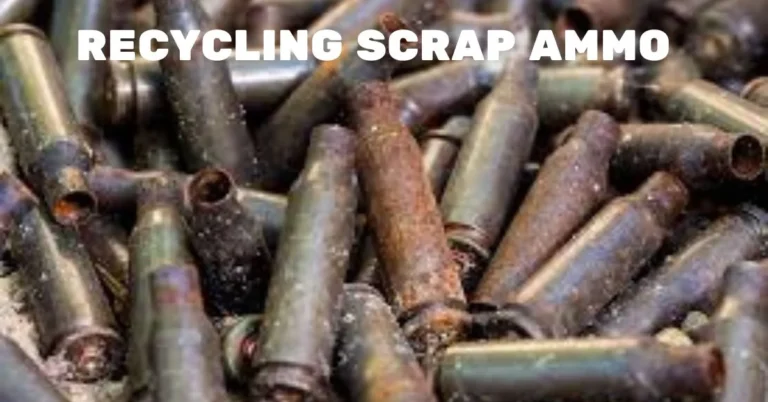Introduction to recycling scrap ammo
Every time a round is fired at the shooting range, there’s a lingering question that often goes unaddressed: what happens to the spent ammo? As gun enthusiasts and hunters enjoy their passion, they may not realize that these little brass casings, lead bullets, and powder remnants have significant implications for our environment. Recycling scrap ammo might not be top of mind for many shooters, but it’s an important step towards sustainability. By understanding how we can responsibly handle this waste material, we open up new avenues for renewal—transforming something discarded into valuable resources. Let’s dive into the world of recycling scrap ammo and explore why it matters more than ever before.
The environmental impact of not recycling scrap ammo
The failure to recycle scrap ammo poses significant environmental threats. When ammunition is discarded improperly, hazardous materials like lead and copper can leach into the soil and waterways. This contamination harms local wildlife and disrupts ecosystems.
Moreover, the production of ammunition requires substantial resources. Not recycling leads to increased demand for raw materials, contributing to deforestation and habitat loss. The extraction processes are energy-intensive, amplifying carbon emissions in an already strained climate.
Landfills overflowing with spent casings represent a wasteful cycle that squanders valuable metals. These metals could be repurposed but instead sit idle in dumpsites, detracting from potential economic benefits through recycling initiatives.
Communities near shooting ranges may feel the impact most acutely as pollutants seep into their environment. By neglecting proper disposal methods for scrap ammo, we risk long-term health consequences for both people and nature alike.
The process of recycling scrap ammo
Recycling scrap ammo involves several key steps to ensure safety and efficiency. First, the collected ammunition must be inspected. This helps identify any live rounds that could pose a danger during processing.
Once sorted, non-hazardous components like casings can be processed further. These casings are often made of brass, which is highly recyclable. They undergo cleaning and melting down to create new metal products.
Next comes the separation of gunpowder and primers from the shells. Specialized facilities handle these materials with care due to their explosive nature. The components can sometimes be repurposed for industrial uses or safely disposed of when necessary.
Manufacturers utilize recycled materials in different applications, reducing the need for virgin resources. By following this structured process, recycling scrap ammo not only prevents waste but also promotes sustainability in various industries.
ALSO READ: Ernest Khalimov: The Man Behind GigaChad
Benefits of recycling scrap ammo for the environment and economy
Recycling scrap ammo offers significant benefits for both the environment and the economy. By repurposing spent casings and bullets, we can reduce waste that would otherwise contribute to landfills. This process conserves precious natural resources by minimizing the need for new materials.
From an economic perspective, recycling creates job opportunities within processing facilities. It also fosters a market for reclaimed metals, which can help stimulate local economies.
Additionally, recycling helps decrease pollution associated with mining and metal production. The reduction in harmful emissions contributes to cleaner air and safer habitats for wildlife.
Moreover, many outdoor shooting ranges are adopting sustainable practices through their recycling initiatives. This not only enhances their reputation but also encourages responsible gun ownership among participants who care about environmental stewardship.
Companies and organizations promoting and implementing recycling programs for scrap ammo
Several companies and organizations are stepping up to pave the way for recycling scrap ammo. These initiatives not only benefit the environment but also foster a culture of responsibility among shooters and gun enthusiasts.
One notable player in this space is the National Shooting Sports Foundation (NSSF), which promotes sustainable practices across shooting ranges. Their resources guide facilities on implementing effective recycling programs, ensuring that lead and other materials don’t end up in landfills.
Another example is local shooting clubs collaborating with metal recyclers. By establishing partnerships, they streamline the collection process, making it easier for members to recycle spent casings after their practice sessions.
Innovative startups are also emerging, offering services specifically tailored to reclaiming spent ammunition components. These efforts highlight a growing recognition of environmental stewardship within the firearms community while providing practical solutions to scrap ammo challenges.
ALSO READ: How Numlookup is Revolutionizing Phone Validation
Challenges and solutions in the recycling of scrap ammo
Recycling scrap ammo faces several challenges. One significant hurdle is the hazardous materials often found in ammunition, such as lead and other metals. These substances require stringent safety measures during collection and processing to prevent environmental contamination.
Another issue is the lack of awareness among gun owners about recycling options. Many shooters may not realize they can responsibly dispose of spent cartridges rather than tossing them away.
Innovative solutions are emerging to address these obstacles. Education campaigns can raise awareness about the benefits of recycling scraps ammo, encouraging more people to participate in programs.
Furthermore, technology advancements allow for safer extraction methods that minimize exposure risks while maximizing efficiency in reclaiming valuable resources from used ammunition components. Collaboration between manufacturers and recyclers also plays a crucial role in creating streamlined processes that make recycling both effective and accessible.
Conclusion: The importance of responsibly handling and repurposing scrap ammo for a more sustainable future
The importance of responsibly handling and repurposing scrap ammo cannot be overstated. As the world becomes more environmentally conscious, every small action contributes to a larger impact. Recycling scrap ammo is not only about reducing waste; it’s a chance to reclaim valuable materials. This practice helps protect our ecosystems from toxic elements that can leach into soil and water.
By choosing to recycle, enthusiasts and shooters are making an active choice for sustainability. It creates jobs within recycling programs and supports local economies while fostering a culture of responsibility among gun owners and recreational shooters alike.
Embracing recycling initiatives signifies a commitment to environmental stewardship. It demonstrates awareness of the consequences our actions have on future generations. Together, we can transform what was once deemed trash into resources for new products, ensuring that nothing goes to waste in this cycle of renewal.
As we move forward, let’s prioritize responsible practices around scrap ammo disposal—turning potential hazards into opportunities for innovation and growth in sustainable development.
ALSO READ: The Future of Industries with TJYFSO4Y4VK
FAQs
What is scrap ammo?
Scrap ammo refers to spent or unused ammunition components, such as brass casings and lead bullets, that are no longer needed for firing. Instead of discarding them, recycling scrap ammo involves repurposing these materials to reduce waste and environmental impact.
Why is recycling scrap ammo important?
Recycling scrap ammo is crucial because it prevents hazardous materials like lead and copper from polluting soil and waterways when improperly disposed of. Additionally, it conserves natural resources by reusing metals like brass, which would otherwise require new mining and production processes.
How does the process of recycling scrap ammo work?
Recycling scrap ammo starts with collecting and inspecting spent cartridges. Non-hazardous components, such as brass casings, are cleaned and melted down to create new metal products. Hazardous materials like gunpowder are handled carefully to prevent accidents during processing.
What are the benefits of recycling scrap ammo?
Recycling scrap ammo offers environmental benefits by reducing landfill waste and pollution from metal extraction. Economically, it creates jobs in recycling industries and supports local economies by reusing valuable materials. Moreover, it promotes sustainable practices within shooting communities.
Who promotes and implements recycling programs for scrap ammo?
Organizations like the National Shooting Sports Foundation (NSSF) and local shooting clubs play key roles in promoting recycling programs for scraps ammo. They provide guidance and resources to shooting ranges and enthusiasts, encouraging responsible disposal and recycling practices.

